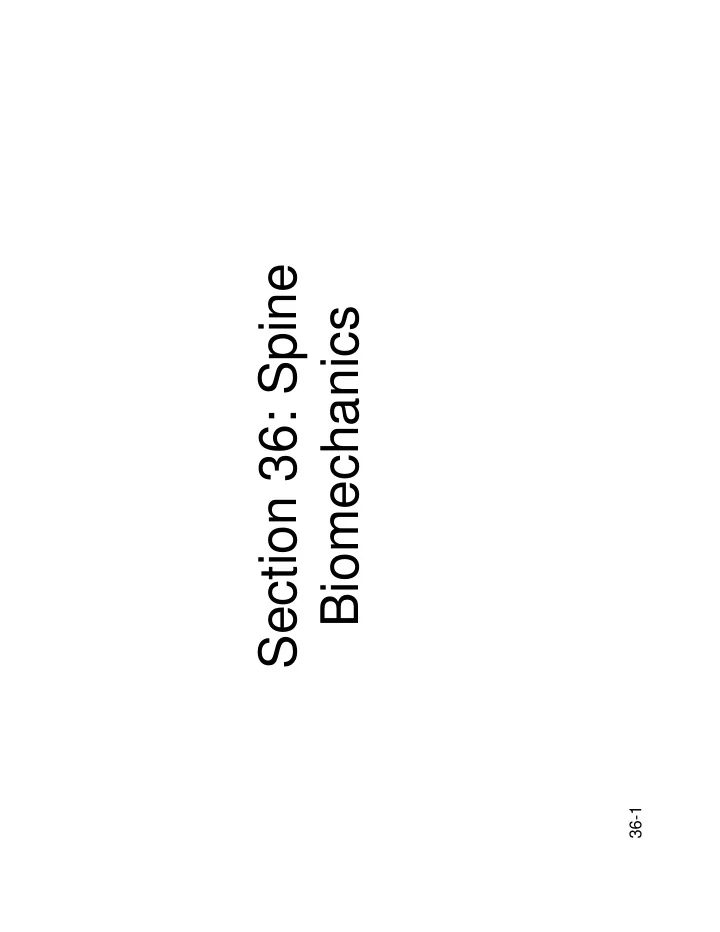

Section 36: Spine Biomechanics 36-1
From: Peeler 36-2
From: Iatridis 36-3
Theory of weight bearing Theory of weight bearing • Nucleus pulpous imbibes water Nucleus pulpous imbibes water • Develops internal pressure • Pressure exerted in all directions • Pressure exerted in all directions – Lateral forces • Against annulus Against annulus – Superiorly and inferiorly directed forces • Against end plates g – Increases stiffness • Of end plate and annulus fibrosus 36-4 From: Ziv
• Nucleus Pulposus Nucleus Pulposus – Eccentrically positioned posteriorly – Young & healthy – Young & healthy • 50% cross-sectional • 90% water, bound to proteoglycans – Aging> dessication> increase viscosity> fissuring – Pascal’s law • Fluid mass within closed container> local increase in • Fluid mass within closed container> local increase in pressure> transmit around entire side wall (annulus) • Young nucleus> even distribution of load • Old nucleus> undue concentration on vertebral body edges Old l d t ti t b l b d d – Small displacement w/ ROM, ball-bearing like – Compressive stress predominates Compressive stress predominates 36-5 From: Yang
From: Iatridis 36-6
Theory of weight bearing (cont’d) Theory of weight bearing (cont d) 36-7 From: Ziv
• Intradiscal Pressure – Compressive loads in vivo: 500N standing, 700N sitting – Increased to 3000 to 6000N during lifting of moderate weights decreases with load closer moderate weights, decreases with load closer to body – Estimate of P = 1 5X compressive load Estimate of P 1.5X compressive load divided by the cross sectional area – Disk pressure is usually uniform – Pressure lowest in supine position – Disk usually does not fail, but end plates f fracture 36-8 From: Yang
Measurements of In vivo Loads Measurements of In vivo Loads • Needle pressure Needle pressure transducer • Calibrated – Introduced into nucleus pulpous of cadaveric functional d i f ti l unit • Inserted in vivo in L3- • Inserted in vivo in L3- 4 disc 36-9 From: Ziv
Shear & Tensile Characteristics Shear & Tensile Characteristics • In direct shear tests In direct shear tests – Shear stiffness in horizontal direction • 260 N/mm 2 • Spine rarely fails in pure shear • Similarly under normal physiologic activities – Pure tensile loading doesn’t occur – But annulus undergoes tensile loading during • Bending • Axial rotation • Extension 36-10 From: Ziv
From: Yang 36-11
From: Peeler 36-12
From: Peeler 36-13
From: Peeler 36-14
From: Peeler 36-15
From: Peeler 36-16
Low Back Pain Low Back Pain • Most frequent cause of activity limitation in people under q y p p age 45 • Direct annual cost of treating low back pain patients – $11 4 billion in 1994 $11.4 billion in 1994 – Not including the secondary costs of lost work and activity • Mechanical loading conditions associated with back pain – Frequent bending and twisting F t b di d t i ti – Heavy physical work – Sedentary environment – Vibration Vib ti 36-17 From: Iatridis
From: Peeler 36-18
Recommend
More recommend